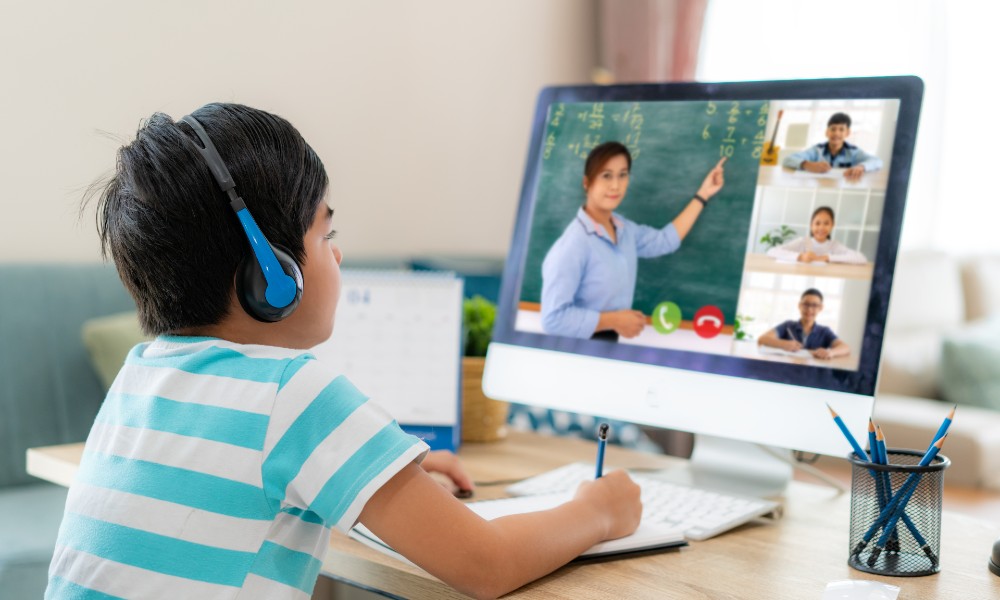
The Covid-19 pandemic affected almost every industry, and the education sector was no exception. While modern technology like smart boards and student iPads had already become the norm in the typical classroom, the pandemic accelerated the use of digital tools in the classroom, radically challenging the very concept of education.
From kindergarten, all the way up to the postgraduate level, schools around the world were forced to quickly shift to online remote learning with the use of digital collaboration platforms to ensure students could still receive their education. A Statista report found that 45 percent of elementary school students used remote learning during 2020, with the numbers being 64 percent for middle schoolers, 63 percent for high schoolers, and a staggering 97 percent for undergraduate college students.
This widespread adoption of technology, such as cognitive computing, high-speed connectivity, and mobility solutions, has completely changed how teachers teach and students learn. Many educational institutes now look at technology as an opportunity to build teaching methods and connect with students efficiently.
"Online learning emerged as a safe and viable option for education continuity as the COVID-19 pandemic turned personal and professional worlds upside down but has since paved the way for a pedagogical shift in the way teachers teach and how students learn," said Jeffrey Singman, SVP Sales and Marketing from Kandy, a cloud-based, real-time communications platform. "In this mode of learning, teachers and instructors now function as guides, while students become active collaborators rather than mere passive learners."
Now, even as vaccines rollout and the pandemic seems to be coming to an end, remote learning and the use of digital collaboration platforms will not be going away anytime soon. In fact, the global remote learning market is projected to grow to 370 billion dollars by 2026 from 226 billion in 2020, a CAGR of 8.56% during 2021-2026.
Driving this growth of remote learning is the innovation associated with remote education platforms, which is making online education more intuitive and easier for students, teachers, and even the parents.
"The benefits technology and distance learning can have on education are endless, with tools and solutions that offer real-time access to data only continuing to improve the role of technology in education," said Singman. "Solutions, such as Kandy's Communications Platform as a Service (CPaaS), will leverage APIs and SDKs to make communication and connecting students and teachers for advancements in learning better and easier."
A CPaaS is a set of communications APIs and SDKs that let businesses and developers integrate features like telephony and messaging into the software. Entirely cloud-based and software-driven, it caters to application developers and product owners who need to tap into exciting digital and mobile features without having to build or locate any of the expensive (and complicated) physical network infrastructure.
"By leveraging Communications APIs and SDKs, it eradicates the need for users to communicate within channel-based silos for instant messaging, web conferencing, text messaging, voice calling, and other forms of communication," said Singman. "A CPaaS solution, such as Kandy's CPaaS, basically lets you turn devices and apps into communication tools."
The potential of CPaaS technology to drive transformation and evolution in the online education sector is endless. One aspect of the remote learning experience that can be optimized through the use of CPaaS technology is the digital classroom. Video chat rooms of anywhere from 10 to 150 teachers and students can benefit from the boosted audio and video quality.
Seamless voice applications with IP-to-IP voice calls, SIP Trunking for PSTN calling combined with high quality, low-latency video with scalable resolution would give teachers and students the ability to communicate clearly in real-time. CPaaS also have exceptional collaboration abilities, allowing for co-browsing screen sharing and WebRTC voice and video, enabling a truly immersive, collaborative educational experience.
With the introduction of programmable communications such as voice, text, and video, CPaaS made it easy to build that suits the school's need, regardless of level.
"Schools can develop precisely the tools they need, using powerful APIs and SDKs to elevate the educational experience they provide for their students and staff," said Singman. "Because every institution needs to communicate with its students and teachers differently, the need for a highly scalable and customizable collection of communications capabilities is clear."
The combination of the growing interest in remote learning and the realizations of the benefits post-pandemic speaks volumes about its inevitable continuous growth. And with the continuance of remote learning also leaves the door open for the adoption of CPaaS as common technology in the education industry to help students, teachers, and parents alike.
"The impact that technology has had on today's schools has been quite significant, as schools are now giving teachers, students, and the administration creative and efficient solutions and services that are improving results and operations said Singman. "CPaaS solutions, like Kandy's, can be the next technological adoption that lets remote learning reach its full potential."
Edited by
Luke Bellos